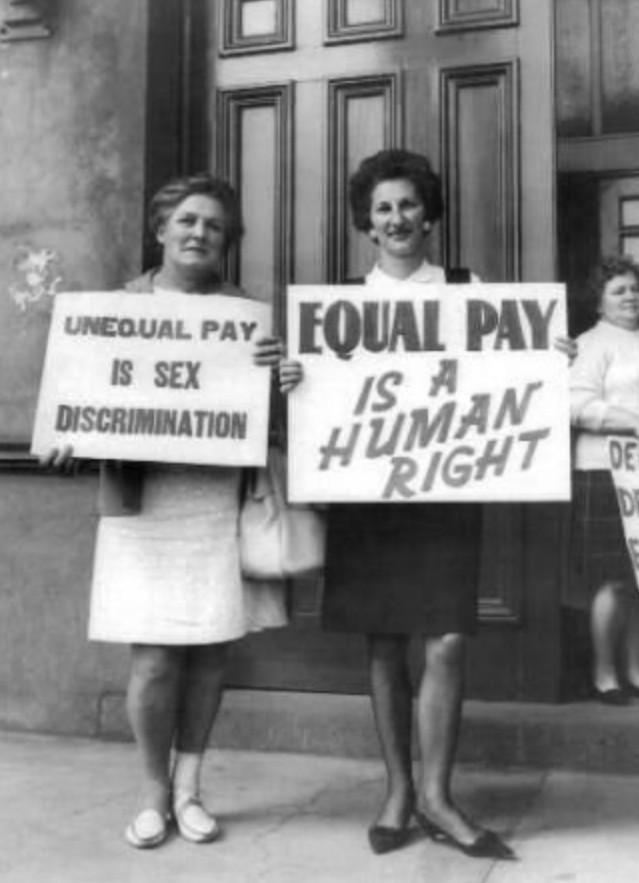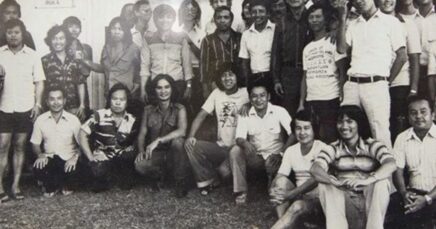On 21 October 1969, legendary union activist Zelda D’Aprano chained herself to the doors of the Commonwealth Building to protest for Equal Pay!
This is her remarkable story.

Zelda was born in 1928 and grew up in the Melbourne suburb of Carlton. Her mother was a migrant from Belorussia and worked in a clothing factory, while her father was a wheelwright from Ukraine. By the time she was fourteen Zelda was out of school and into the workforce, losing a series of jobs in various Melbourne factories after she kicked up a stink over unsafe working conditions. She later worked as a dental assistant and then qualified as a dental nurse, and was activist in the Hospital Employees Federation. She got politically active, joining the Communist Party of Australia.

In January 1969 she started work with the Australasian Meat Industry Employees’ Union, and soon gained a reputation for her courage and willingness to call out sexism, including within the union movement.
In June of that year, the Meat Industry Union was one of the trade union’s that brought a historic equal pay case to the Arbitration Commission alongside the Australian Council of Trade Unions (ACTU). The union advocate in the case was Bob Hawke, then working for the ACTU.

The evidence Hawke presented, Zelda later recalled, was ‘profound and irrefutable’. But the hearing itself was far from favourable for the working women who were pressing a claim for equal pay. Zelda, who was present throughout the case, remembered the alienating atmosphere of the hearing, presided over by four male judges.
She wrote in her memoirs that ‘the women sat there day after day as if mute, while the men presented evidence for and against their worth. It was humiliating to have to sit there and not say anything about our own worth. I found the need to sit there silent almost beyond my control and was incensed with the entire set up.’
On June 19, the Commission returned its decision in favour of ‘equal pay for equal work’.
While this sounds positive – and it was certainly a step forward – many activists such as Zelda were disappointed. The decision was very limited in scope, applying only to work that men and women performed in the same manner in the same industry, affecting less than 18% of working women (predominantly in the public service). This left all those women who worked in female-dominated industries that had been systematically undervalued without equality, paid less than men who performed comparable work.
Zelda felt this disappointment keenly, and she decided that she’d had enough of silence. It was time for action.
On 21 October 1969, Zelda went to the Commonwealth Building, where a number of government offices were located, and chained herself to the entrance of the building. Other women activists marched up and down with placards chanting to draw attention to Zelda’s action, and the significance of the cause.

In an interview Zelda later explained the events of the day:
‘Well, I had to go and case the joint and look to see where the handles were on the doors. Then I was able to get the chain donated from the Painters & Dockers Union. And I had to buy the locks myself. And I had it all arranged, and I was very nervous, and the day came and we notified the press and the television stations, and I went ahead and I chained myself across the door of the Commonwealth Building in Melbourne over the injustice done to women over salaries. And I had the women there to give me moral support. And the Commonwealth Police came, and — eventually —cut me off the chains.’
This activism intended to draw attention to the ongoing cause for equal pay. The 1969 decision was not enough, all women workers should get paid equally, and the historic undervaluing of women’s work needed to be corrected.
After her heroic action Zelda was soon approached by two trade union activists in the teachers’ union, Alva Giekie and Thelma Solomon, who volunteered to take part in a similar act of defiance. It was decided that the next target for protest would be the Arbitration Commission building, as it was there that the inadequate decision on pay equity had been made. Zelda took it upon herself to examine the doors at the building and decide how much chain would be needed. This time, the Builders’ Labourers Federation donated the chain for the action. But Zelda had to buy her own locks.
On 31 October the three women chained themselves to the doors of the Arbitration Commission. She recalled that:
‘There was just sufficient chain to allow the door to open slightly, and people had to bend down and crawl in sideways to enter the building. This was so undignified for the “important” people.’
In 1970 Zelda, and other women comrades, formed the Women’s Action Committee, which agitated for equal pay, and protested other forms of sexism in Australian society. In one protest they took a tram ride, and when the conductor approached them to pay for their ticket, they only paid 75% of the fare. Women and men did not receive the same wages based on their gender, they argued, so why should women be expected to pay the same amount as men?

The campaign for equal pay was far from over. Zelda and her comrades had made an important stand, ensuring the issue remained in the public spotlight, and providing vital life to the continuation of the campaign. This was strongly backed by trade unions, such as in the Metal Trades, which made direct demands on employers for equal pay for women in the industry immediately!
In 1972, the Arbitration Court heard another ACTU-backed claim for equal pay and determined that the principle should be ‘equal pay for work of equal value.’
It was an important milestone in the continuing march towards gender equity, and a testament to the trade union women, such as Zelda, who had campaigned for decades for this recognition.

Zelda remained a fighter throughout her life, passing away in 2018. She will forever be remembered by a grateful movement as a true trade union legend.



